| 當 Garmin 的先驅機種 310XT 上市的時候, 我們可以看到一個從 Garmin 的 305 到
Forerunner 310XT 的合乎邏輯演變.
它也實現了對了許多鐵人三項選手所需功能的承諾,同時也承諾了單項體育的運動員和騎自行車的人群對某些功能的呼籲。
大多數人都為 310XT 新增的三大功能感到興奮:
1) 更久的電池操作續航力 (比先前機種多了 10 個小時)
2) 更深的防水能力 (為了游泳的需要, 深度現已超過 30 公尺, 規格為 50 公尺)
3) 整合循環功率器(記錄瓦數)當然了, 這只是一項小突破. 如何再超前到一個月以上的續航力還有待努力
I初始設定:
當您第一次開機啟動了 Garmin 310XT它會問你一系列問題。之前 Garmin 305
也做了同樣的事情 -
1) Language 選用的語言, 310XT 沒有中文版本.
2) Time Format (12/24 hr) 時間顯示的格式
3) Distance format (Miles/KM) 距離顯示的格式
4) HR Monitor (Yes/No) 您使用心率帶嗎?
5) Select gender (M/F/Confused) 性別
6) Enter Age 年齡
7) Enter Weight 體重
8) Enter Height 身高
9) Specify Activity Class 運動的等級
10) Specify Lifetime Athlete 運動的歷史 * 註:
 |
 |
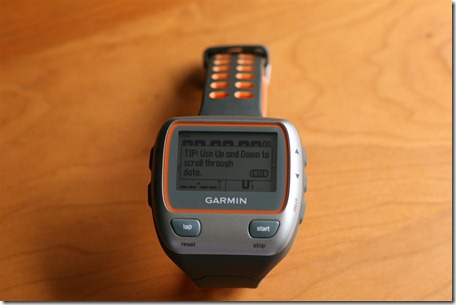 |
|
|
最後兩個是還挺有趣的,尤其是“你是一輩子的運動員?”。這個問題是針對靜態心跳率小於
60人們而言,或者是已經運動多年的人們。雖然手冊沒有說明此設置實際影響,也許它對於一些控制熱量計算相關吧.
理論上, 長期有充足的運動量的人, 心跳會比較慢些. |
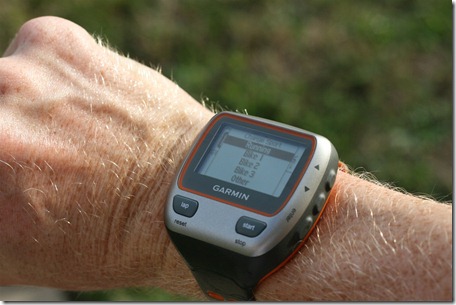 |
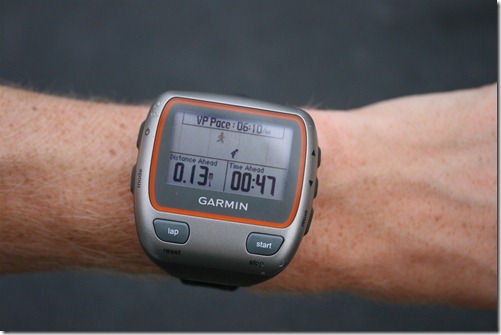 |
| 它小於以前的前身機種。更輕。也更精簡 - 操作方式也更容易.
基本上它很像是一台小計算機
一旦你開啟電源後,你就可以選擇你做哪些運動(按住模式按鈕幾秒鐘)。這個設計相當的方便,
經由快速鍵可以省去以前要操作一堆目錄的方式. 採用 SiRF 的快速定位晶片,
要比前版各機種要快得多.
假如, 您己經準備好要上路跑個幾圈了. 只要按下 start 即可問始.
310XT
不但有聲音提示,還有震動提示,只要您熟悉其各種提示後,即使在吵雜的環境下,不用傾聽也能知道它所傳出的震動提示。當您開跑時,310XT
的顯示會開始調適與計算速度,並以聲音與震動提示您。
當您放慢速度時,310XT 會提示您現在速度正在放慢,這是根據您自己在 310XT
中設定的 ZONE 值而定的,您還可以依速度,心率各自設定高低區域讓
310XT在偵測到這些區域時提示您。
- 虛擬伙伴: 這個功能在早期的 Forerunner
系列產品中就有了。借由顯示器上的一個小小的跑者圖示,虛擬一個與您一起跑步的伙伴,這個伙伴會根據所設定的運動訓練計劃表的數值,借由這個方法,您可以比對一下您現在的速度與距離是不是落後或超前以便於隨時調整您的步伐。
|
 |
 |
| 上圖是設置一個使用者的參數,
您可以設置十個名稱與內容不同的參數檔. 右圖是所建立的訓練計劃表, 若您隨便設置的話,
310XT 會在偵測到不合理的設置情況時提醒您.
310XT 使用 SiRF 的高感度 GPS 晶片, 在樹蔭濃密的小徑依然能定位,
若您經過高架道路下時, 即使完全收不到 GPS 訊號,
它也會自動在下一筆可以定位的點位之間連結, 讓航跡可以連續. 下圖所示;
|
 |
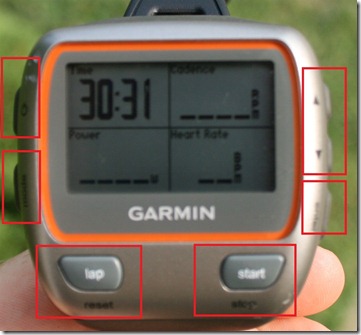 |
|
上圖右, 310XT 的按鈕, 右側上面一對上下標記的按鈕, 請參考說明書所列的操作指示.
操作上是精確實用的, 要比一些感應式的方式 (Forerunner 405) 要清楚得多.
|
 |
| 上表是當您每按下一個 start 動作的記錄:
單車運動;
單車運動是 310XT 的強項之一, Garmin 為了將 310XT
固定在單車上也設計了專用的固定座: |
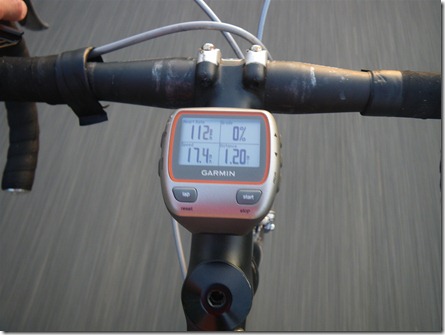 |
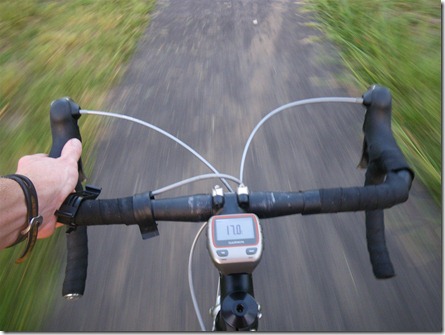 |
 |
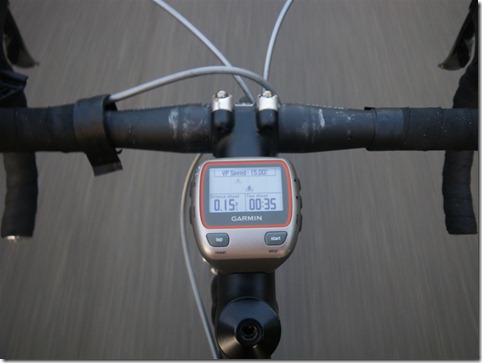 |
| 自動暫停記錄的功能: 對單車運動而言,
自動暫停記錄的功能很實用, 這個功能是根據速度來啟閉 310XT 的記錄功能. 當單車停止時,
310XT 自動停止記錄, 再開始騎乘則回復記錄. 速度的依據是可以設定的.
310XT 能記錄的項目有: 速度,
高程, 心率, 距離. 踏頻 (需加裝 SGC-10), 功率 (功率計)
..隨後可以配合各種相容的軟體進行運動分
|
 |
 |
| 功率計的支援是 310XT 之前機種所沒有的功能. Garmin
並沒有生產功率計, 這類設備現在都是各種不同專業領域的廠商各自開發的, 在台灣,
比較常見於單車運動的功率計有 SRAM 公司的數款單車前大盤整合的功率計.
這個連結有特別針對單車用功率計的說明.
Cycling with Power here. 除了前大盤外, 也有和後輪花鼓式,
基本上必需是以 Ant+ 為基礎的才能用. |
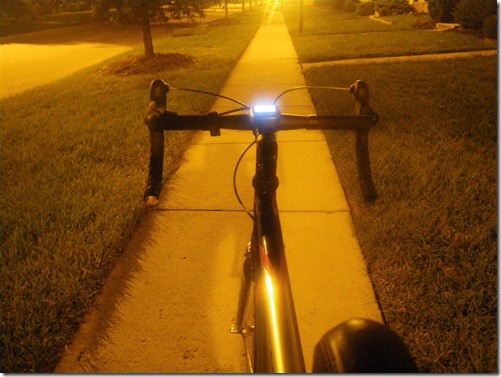 |
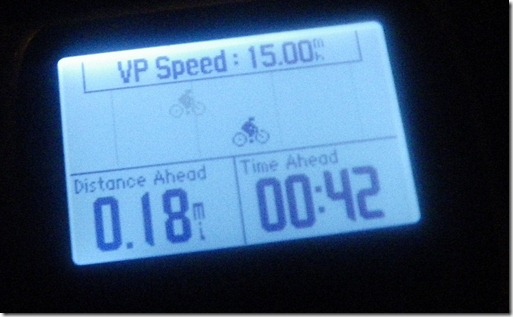 |
| 上圖為啟動照明後的一台固定在單車上的 310XT. |
| 游泳: |
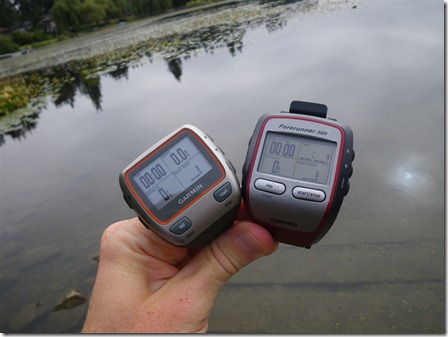 |
|
| 上圖是前版 305 與 310XT 的比較.
不論是體積或重量有進步, 防水更深, 電池續航力也大增 |
 |
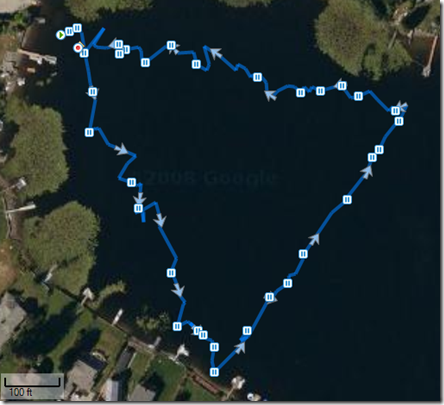 |
| Garmin 305 Track – Lap
1: |
Garmin 310XT Track –
Lap 1: |
| 305 與 310XT 在航跡記錄上的差異. |
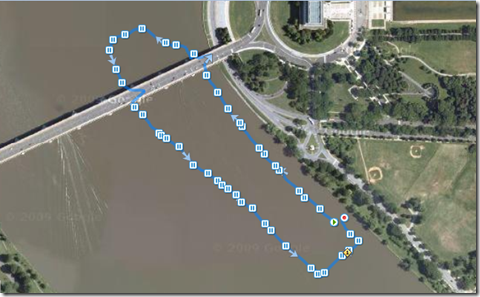 |
 |
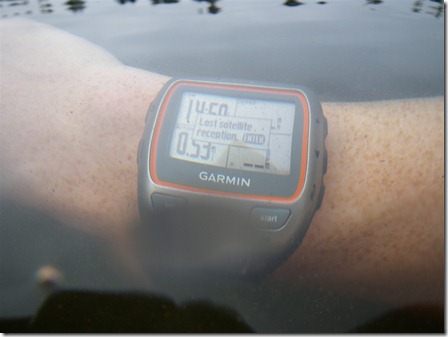 |
一進入水中, GPS 的訊號就會中斷. |
| GPS 的訊號無法穿透水下, 將它稍為沉到水下 310
會立即顯示失去衛星訊號. 下面左圖是將一台 305 固定在泳帽上, 右圖則是將 310
戴在手上, 由於 GPS 在水下收訊不良, 可以看到航跡組成變得不平滑,
想必是間歇性的定位不良所產生的漂移 |
| |
|
 |
 |
| Garmin 305 Track
(裝在泳帽上) |
Garmin 310XT 佩帶在手腕上 – Lap 2: |
| 由於 GPS 訊號難以穿透水, 帶在手腕上有時會失去 GPS
訊號而中斷, 雖然記錄的航線會像上面右圖, 但不會對資料的分析上影響不會太大. |
| 心率帶在水中似乎能正常工作, 可能是心率帶與 310XT 的距離很短的原因.
不過在水底下兩者的距離若太遠的話, 學理上, 傳送上還是會中斷的. |
 |
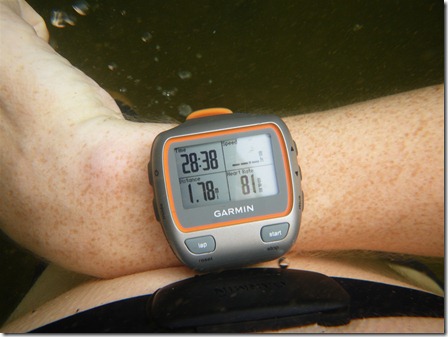 |
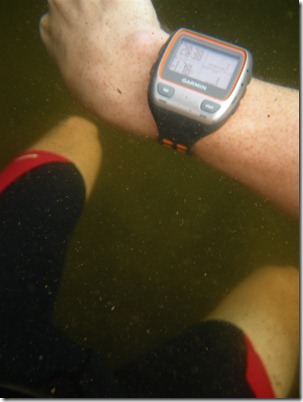 |
|
訓練註記:
對於多項運動的切換, 310XT 提供了一個不錯的混合模式, 經過設定,
您可以單鍵在各種運動模式切換.
|
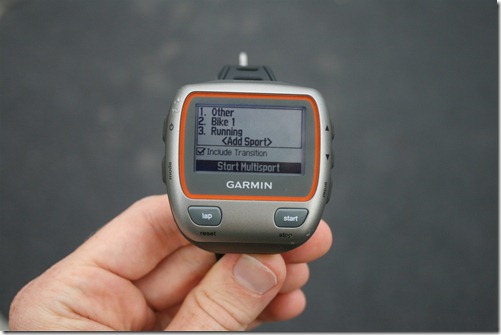 |
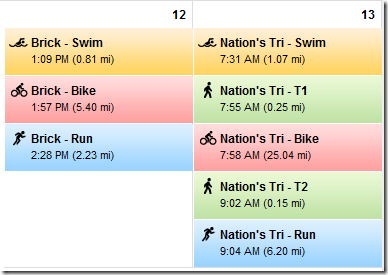 |
| 從上圖可以看到 310XT 可以自行加上不同的運動模式.
並分類記錄資訊 |
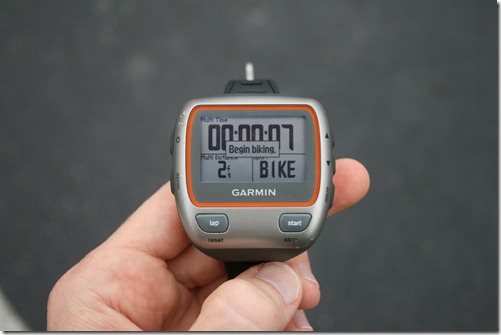 |
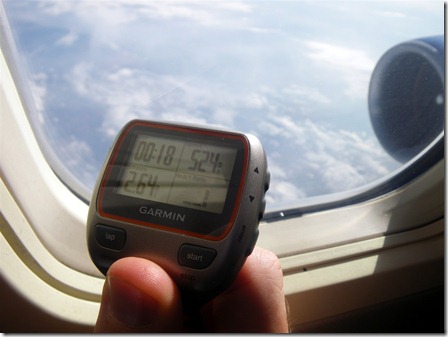 |
|
記錄飛行的航線:(註: 速度為 524MPH)
|
| 下圖是從西雅圖到 DC 的飛行路線, 310XT
可輕易的記錄這段航線, 所記錄的航線待會可以輸入到 Google Earth
一類的應用程式中展現. |
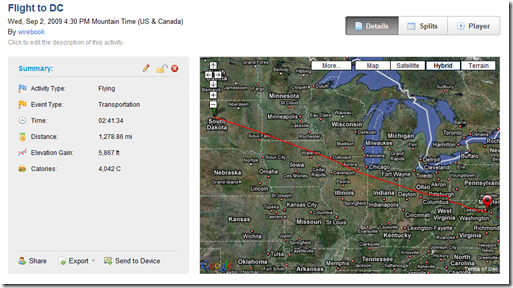 |
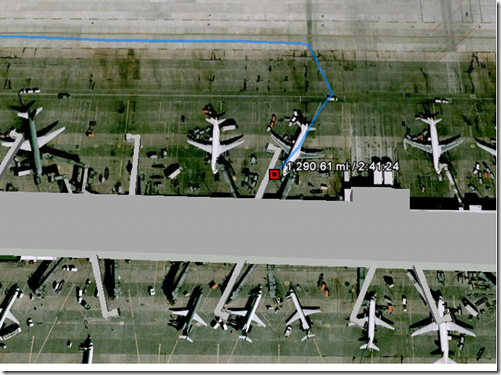 |
| Geotagging 是一將您的照片秀以所拍攝的地點上應用例.
基本上它是比對檔案的日期時間與 310 一類 GPS 的航跡資料來運作的.
您可以很簡單的按下 start 鍵以啟動 310XT 來記錄您的航跡, 待會再用 Garmin Connect
連接再匯出成 GPX f檔. GPX 檔是一種通用的 GPS 資訊交換格式檔,
可方便的與各種不同的應用程式間轉換或直接的取用. 所以, 只要有了 GPX 檔,
您可以用來做很多很酷的運用. 如下例的, 將您旅程中所拍攝的照片對應拍攝的地圖自動同步展示在
geotag 中的正確地點.
應用程式中像 Picasa Web 將可自動的展示您的照片顯示在地圖上.
Geotagging photos:
|
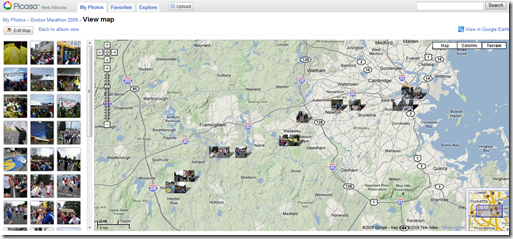 |
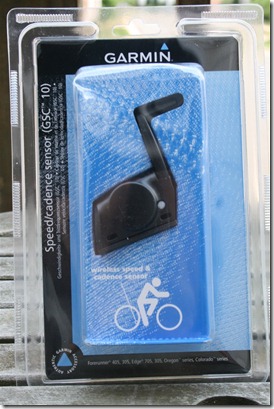 |
| 任何具有記錄功能的 GPS 接收設備其應用面其實是非常的廣泛的,
配會許多程式師所發展的免費或付費軟體, 您所需要的只是無窮的想像力. GPS
是您上山下海, 各種戶外活動不可或缺的伙伴, 即使沒有地圖顯示的 GPS 只要配合方法,
一樣可以實用於導航上. 配合所記錄的航跡, 和適當的軟體, 它的功能超乎您想像好玩
相關附件:
就如同所有 Garmin 運動專用型 GPS 設備,
310XT 相容於各種 Garmin運動用附件. 包括較早期的型號.
310XT 可相容於許多 ANT+ 無線協定的設備.
ANT+ 是一種超低功耗的無線電數位網路設備專用協定, 310XT
使用它與各種附件如 心率帶, 單車踏頻傳感器, 單車功率率等等設備通訊. 理論上, 310XT
應可以和任何使用 Ant+ 協定的設備配對使用, 無論是不是 Garmin 所產製的. Ant+
使用預先規劃 8 組信道的協定,
踏頻/輪速傳感器:
310XT 隨貨所附上的心率帶以外, 單車踏頻輪速傳感器 SGC10
是大多數人主要選購的附件. 它主要的功能除了將您的踏踩節奏傳送到 310XT 之外, 在 GPS
收訊不良的地方自動由輪速中取得車速. 有些人會在室內使用單車練習台, 這時 310XT
就能經由輪速取得速度了.
有一點請注意一下, 310XT
預設的運動模式為跑步, 您必需按住 Mode 鈕一秒, 將運動模式切換到單車模式才能收到
SGC10 的訊號, 在顯示下方也會顯示一個單車圖示, 同時虛擬伙伴也會變成一個騎乘單車的圖示了
|
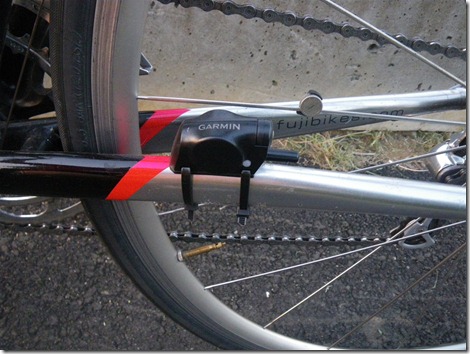 |
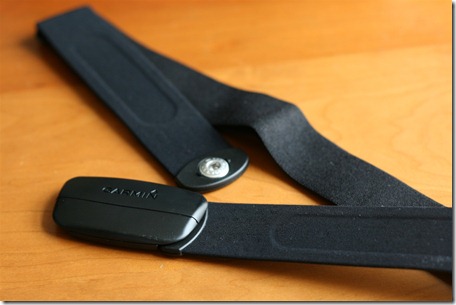 |
| 安裝 SGC10 約只需要兩分鐘,
兩個磁鐵分別安裝在曲柄與後輪的幅條上, 再用束帶安裝 SGC10 於右後三角即可.
心率傳感器:
隨 310XT 所附上的心率傳感器比之前 305 所附的要小, 輕, 佩帶也較舒適,
不過這兩種傳感器是相容的
|
 |
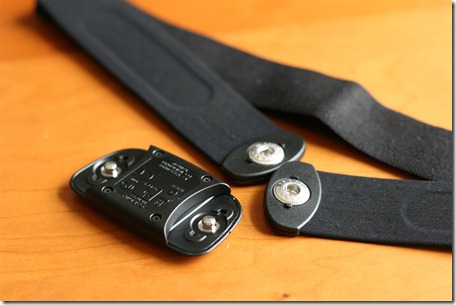 |
| 上面左圖為前 305 所附的款式, 右圖則是 310XT
所附上的款式, 改良不少地方, 更易於佩帶也更輕巧. 步幅傳感器 Foot pod (for running indoors):
Foot Pod 也是有新款, 如下圖右款為新款, 它要比前款小得多, 約是一半大小吧.
|
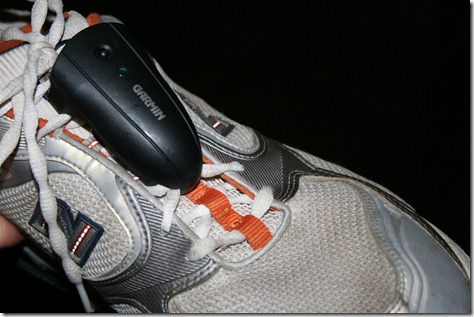 |
 |
| |
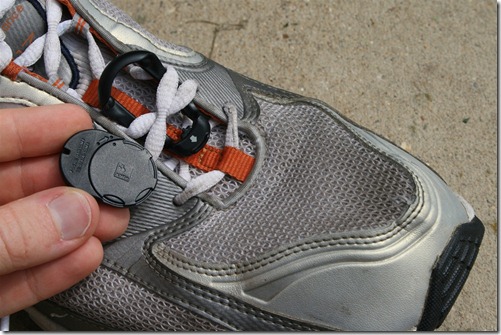 |
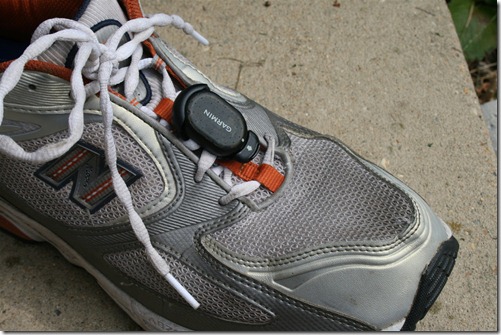 |
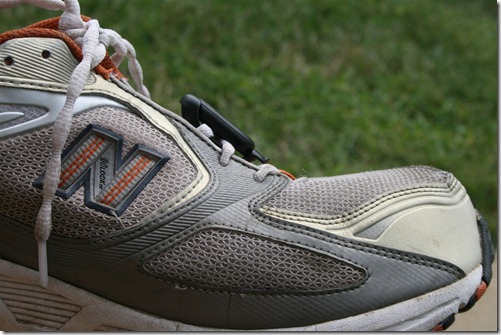 |
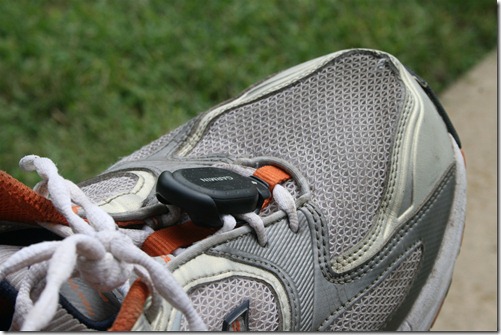 |
| 毫無疑問的, 新款式在佩帶上真的改善了許多,
只要注意上下方向要正確. I’ve found that typically the foot pods are
within about 1-2% distance-wise on my treadmill
runs. So if the treadmill says 1.00 miles, the
foot pod may say .98 to 1.02 miles – well within
the margin of error of the treadmill itself
(yes, they aren’t perfect). Also, one
interesting change is that the new ones don’t
require you to remember to turn them on/off to
save battery (which is a quick user-replaceable
item when the time comes). They just
automagically do it – which is nice.
One other item to note is that the foot pod
measures running cadence (turnover) as well.
This is true of both indoor and outdoor works
(even when the GPS is used). Here’s what that
looks like on a graph |
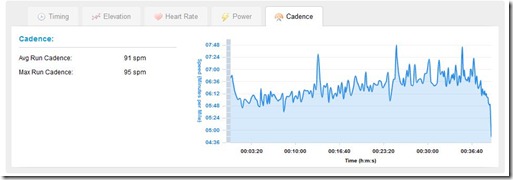 Power devices (cycling wattage):
One of the huge draws to the 310XT for the
cycling/triathlete crowd is the ability for the
310XT to accept power meter devices. These are
devices that measure a cyclists true effort of
work as they exert energy to move the bike. I
wrote an introductory piece to cycling with
power here.
The 310XT is compatible with virtually any
ANT+ Power Meter. This includes models such as
the Power Tap, SRM and Quarq Cinqo. And, over
the past few weeks at major bike shows, numerous
other ANT+ power meters have been announced
which will hit the market over the next 6-12
months. So expect this space to grow pretty
significantly.
An example of one type of power meter is the
Quarq Cinqo that I have, pictured below: |
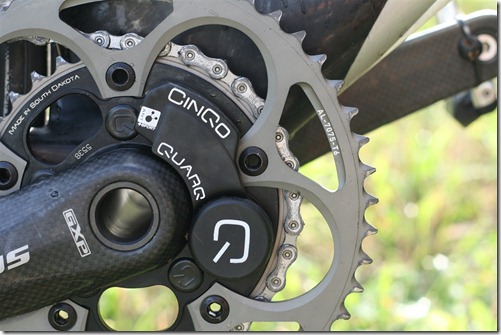 |
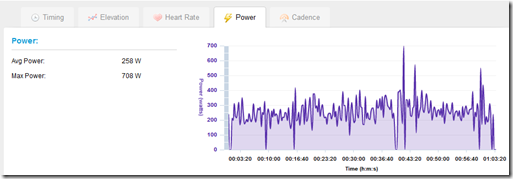
|
| TheCinqo
wirelessly transmits data to the 310XT, where
it’s both displayed and recorded for later
analysis. From there you can view the data on
Garmin Connect, as well as any of the other
compatible software application. Here’s an
example of the data in Garmin Connect: |
| Now this is where some of the
310XT’s weaknesses start to become apparent.
Garmin Connect isn’t really a very useful tool
when it comes to power analysis. Most folks who
utilize power are really looking to get
extremely detailed information, and Garmin
Connect simply doesn’t deliver that. Further
complicating the issue is how the 310XT works
with Smart Recording. Here’s a little snippet
from a Garmin engineer on how it works:
“During smart recording the power during
these intervals is accumulated. When a point
is dropped the accumulated power is divided
by the time to get an average power over
that time interval. The definition of smart
recording includes many variables with power
being one of the items that can trigger the
code to drop a point (after the accumulated
power has reached a threshold). Turning and
distance are other variables that can affect
when a point should be dropped in smart
recording.”
Now, what’s interesting here is that the
Garmin 310XT actually automatically goes into
1-second recording mode when a power meter is
attached (thanks Lisa for pointing this out!),
and if you go and check out the TCX files, you
can see the 1-second increment in times:
|
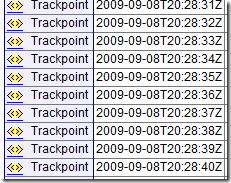 |
|
| Finally, the last area that the
310XT suffers in from a power perspective is the
lack of ability to display what are called
‘Rolling averages’. These are numbers that are
displayed on the screen to show you the average
of the last few seconds of power data. When
cycling with power, the actual power number is
constantly jumping around (this is completely
normal), one second it’s 258w, and the next it’s
198w. This makes it difficult to train/race
based on real time data. So power meter
companies instead offer a screen which
‘smooth's’ this data into readable chunks – such
as 5s and 30s views. And in fact, the Garmin
Edge 705 recently had this feature added. But
the 310XT did not, it only shows instantaneous
power – which is much more difficult to read.
This seems to limit some of the on-bike
usefulness of the 310XT when it comes to power
meters. And that’s all before we even get into
features like zero averaging…which I’ll leave
alone for today.
In summary, while the 310XT is good
‘functional’ as a power meter recording device,
it’s really not ideal as of today when compared
to the 705 or other power meter devices. The
good news here is that Garmin has added these
features to the 705 line, which means that
perhaps we’ll see them added to the 310XT line
as well in the future (via free software
upgrades, like the 705). And again, if you
don’t have a power meter, then this whole
section is moot for ya.
Quick release kit/Cycling Mount:
The quick release kit is targeted at
triathletes that want to be able to quickly
remove the 310XT from the bike and take it with
them on the run. Now, you could do this all
with the default wrist strap – but if you’re in
the aero position for 5+ hours on an Ironman,
the angle of your wrist makes it difficult to
see the display at all times. So for both
cyclists and triathletes, the quick release kit
offers an easy way to mount it on your bike.
The kit comes with basically three major
pieces:
1) A new wrist strap (kinda flimsy)
2) A mounting piece for your bike (not flimsy)
3) A new clip for the back of the Garmin unit
|
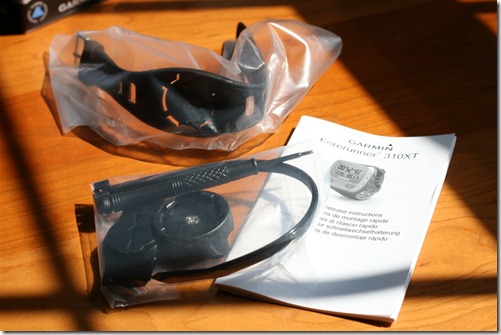 |
 |
| You simply
use the little tool (included) to detach the
existing orange wrist straps, and reattach a new
(thinner) black wrist strap. Then you re-attach
just the metal pins to the black mounting
bracket (see above, left hand side of photo) to
the Garmin itself. |
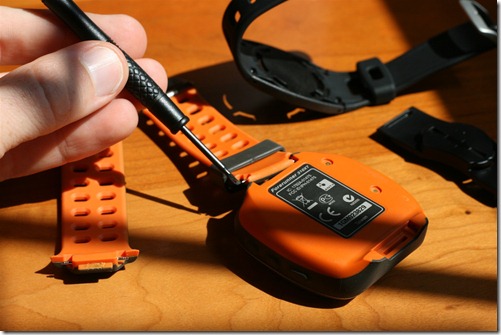 |
 |
 |
|
| One problem that plagued the 305
quick release kit is it’s desire to occasionally
release the watch while cycling along at 20MPH,
thus sending Mr. Garmin flying through the air.
However, the 310XT does not have that problem.
The new quick release kit requires a 90 degree
twist to unlock – and it requires a fair bit of
twisting force to do so. There’s no way in heck
this thing is ever popping off. And, by using
the quick release strap, it’ll fit much more
comfortably in your swim cap if you use it
during a race or training The only minor
complaint I have about the quick release kit is
that I found during transition in a race, it can
be a bit hard to quickly pop on/off if you’re a
bit rushed. In addition, I think I prefer the
orange wrist strap over the thinner but more
flimsy feeling black one that’s included in the
kit. Here’s it attached to both my triathlon
bike, and my road bike (I included tons of
mounting pictures in the gallery at the end):
|
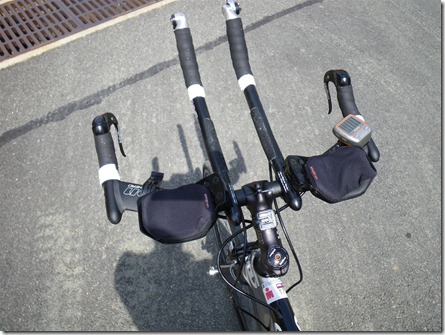 |
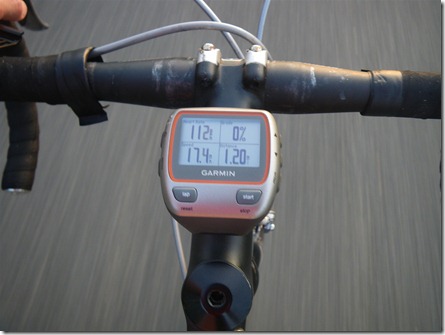 |
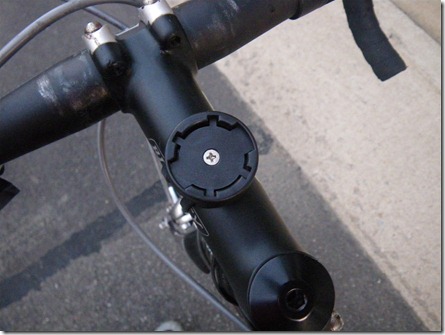 |
|
| That said, for triathletes, the
quick release kit is a must. It’s priced at
very reasonably at $25 on Garmin’s site, or
$21 on Amazon. Note: I’ve included a
bunch more photos of the mounting bracket and
mounting options for both tri and road bikes
within the gallery at the end.
The Fabric Strap (well…sorta):
In the past
the quick release kit actually included a
fabric strap (for the 305). This was probably
the least known secret of the Forerunner 305
series, as the fabric strap was ten times better
than the plastic strap. But, there doesn’t yet
appear to be a fabric strap directly available
for the 310XT. That said, after some curiosity
I tried out the new
405/405CX fabric strap, and it kinda sorta
works. By kinda sorta I mean that it’s clearly
not designed for it, but could be used in a
pinch. That said, I found it pops off quite
easily (even if you use the right pins), so I
wouldn’t really recommend it. But I wanted to
include it here for now, since I know someone
would be curious. You can see in the below
photos how the strap is about a third of an inch
too long, and bunches up below my wrist:
|
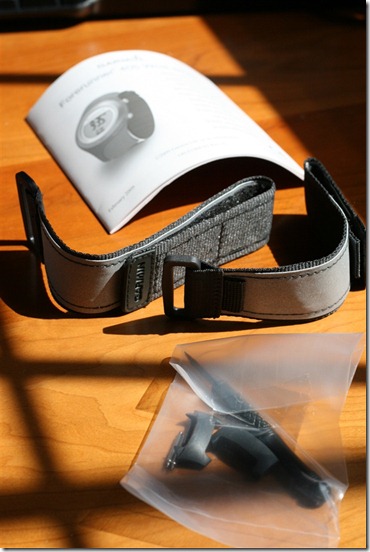 |
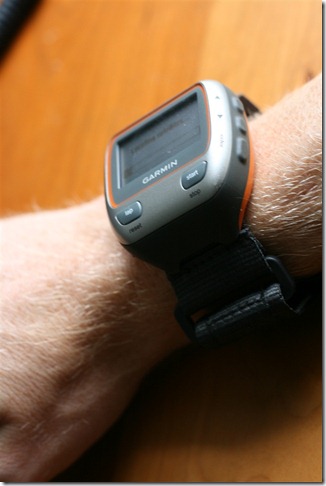 |
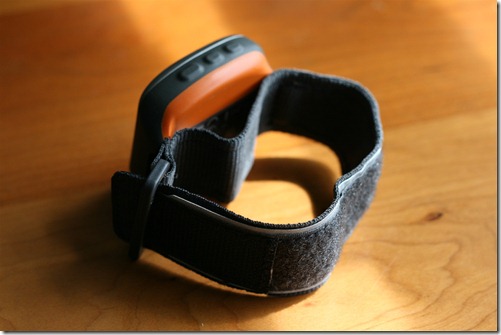 |
|
| Tanita BC-1000
Scale:
The
Tanita BC-1000 scale is a wireless ANT+
scale that synchronizes to both your 310XT as
well as your computer – wirelessly sending your
weight, body fat and other health related
details right over just like red rover. I
reviewed this scale recently and have now
updated this review (the 310XT) to include
details about it, since it’s one of the few
devices that can interact with the BC-1000.
The Garmin 310XT acts as a data repository
for the scale data, which is then transferred to
your computer when you sync the 310XT with the
little USB stick. Finally, that data is in turn
sent to both Garmin Connect, and also the
Healthy Edge software that comes with the scale.
You first need to enable pairing between the
BC-1000 and the Garmin 310XT via the menu
system, but it’s quick and only takes a secon
|
 |
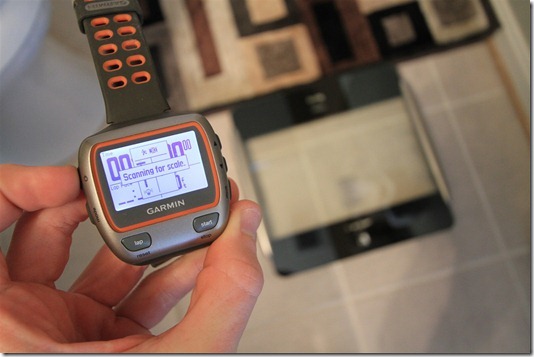 |
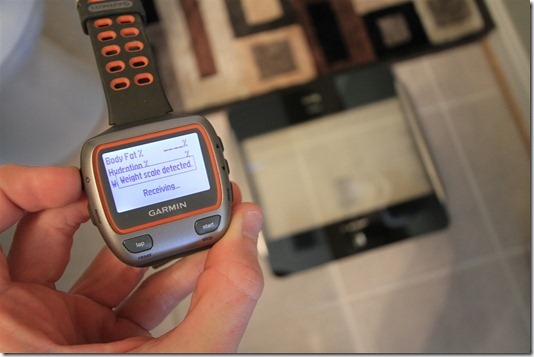 |
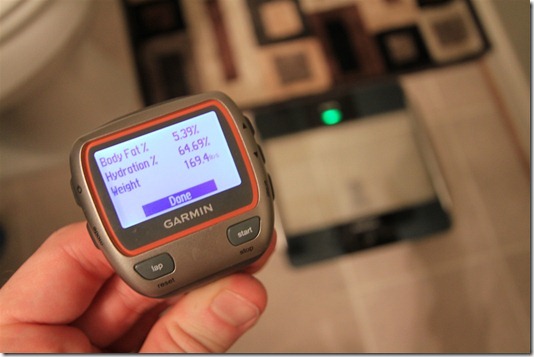 |
| Once that’s done, your set for
any future synchronization with the scale.
With the latest 310XT firmware it’s super-easy
to get your watch to see and talk to the scale
(there were some earlier issues). All you do is
just tap the power button once briefly and it
goes off trying to find it’s floor-bound friend
– the scale:
Once it’s found the scale, the scale will
start blinking. Simply step on the scale and
your weight information is automatically
transmitted to the 310XT within about 2-3
seconds. Super quick.
From there on your next synchronization it
will go ahead and automatically sync that data
to your computer and in turn to Garmin Connect:
|
 |
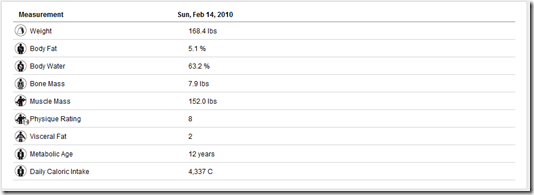 |
| The Tanita BC-1000 is also
compatible in much the same manner with
the Garmin FR60 as well. The scale is
available from a few places including
Amazon and costs about $280. You can check
out my
full review of it here – complete with all
the details you could ever want.
Summary of Accessories:
Here’s a quick table of all the accessories
offered (or that work with) the Garmin 310XT:
Software Options:
Wireless synchronization (Garmin ANT+
Agent):
The first software component that’s required
with the 310XT is the wireless synchronization
piece. Unlike the 305, this watch doesn’t
actually sync with a USB cable (that’s only for
charging now). Instead it uses ANT+ wireless
technology to synchronize. You plug-in the
little USB dongle into your USB port, and you’re
good to go.
This in turn connects to the Garmin ANT+
agent software, which controls synchronization
between your 310XT and your computer (as well as
any other ANT+ devices, like the 405). The
software has made some major improvements since
I first reviewed it when the 405 came out,
with a steady stream of updates over the past 18
months. The wireless experience is now
basically seamless without any of the hiccups of
the past, even on the newly released Windows 7.
Initial setup is easy and only takes a few
moments:
|
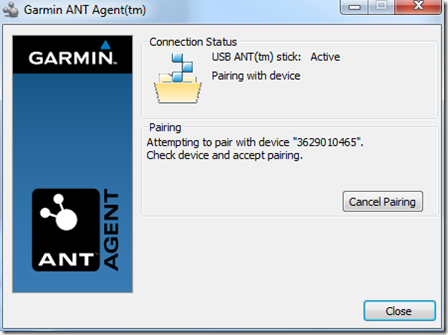 |
 |
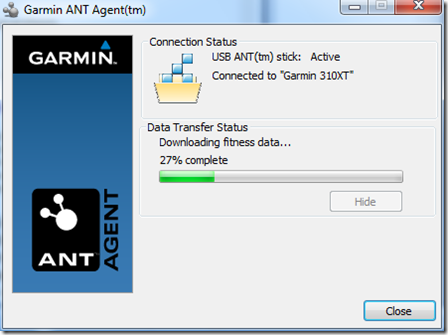 |
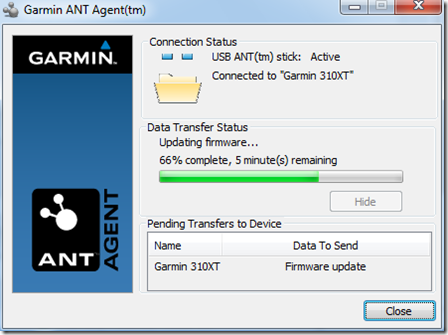 |
| In addition, the ANT+ Agent
helps to manage firmware updates. Firmware
updates a pretty critical to ensuring your
device is running the latest software. There’s
already been quite a few updates for the 310XT –
fixing a bunch of initial bugs – so by using the
ANT+ Agent, you’ll ensure your device is up to
date. Now, to be fair – you really don’t have
a choice when it comes to using the ANT+ Agent
software. It’s the only way to get files off
your watch. You can decline firmware updates
however. Now, one interesting thing is that
many ‘advanced users’ may want to access the TCX
files directly. These are the files that can be
loaded into applications like WKO+ and Training
Peaks. One semi-undocumented feature is that
all of these files are actually in a simple
folder in your user profile, located here
C:\Users\rainmaker\Application
Data\Garmin\Devices\3629010465\History
(XP/2000 users just replace “Users” with
“Documents and Settings”, also note your Device
ID will differ from mine)
 |
Oh, and on a Mac, it’s located
here:
Macintosh HD\Users\username\Library\App
Support\Garmin\Devices\<unit id>\
Pretty cool, huh?
That reminds me…Mac software. The Garmin
ANT+ Agent works just fine on a Mac, so you’ll
be able to upload to Garmin Connect (below),
without issue.
Garmin Connect:
Garmin Connect is essentially a web-based
application that allows you to view your
workouts, share them with others, and store them
for late retrieval. Garmin Connect first
launched when the Edge 705 and Forerunner 405
came out. And it was pretty rough at that point
(and for quite a while afterwards). But Garmin
has made a bunch of good strides with it,
especially since transitioning everything over
from Motionbased.com into Garmin Connect.
When you wirelessly sync your watch, one of
the options is to send the data to Garmin
Connect automatically. This is the easiest
option, and it’s what I do.
|
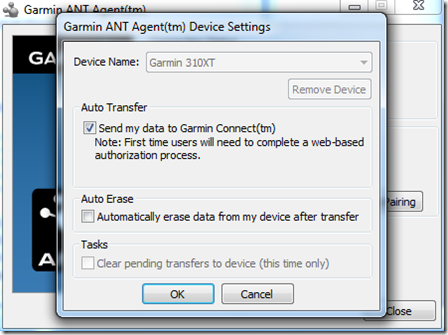 |
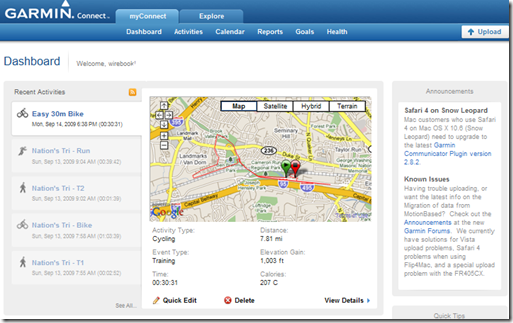 |
| From there you’ll login to
Garmin Connect, which will display a basic
dashboard of your most recent workouts. It’ll
also alert you to any software updates for the
device as well.
On the left hand side you’ll see your
activities, which you can click on to display
more information about each activity. You’ll
see you can also share any given activity with
friends (or the whole world, as I have done
below).
|
 |
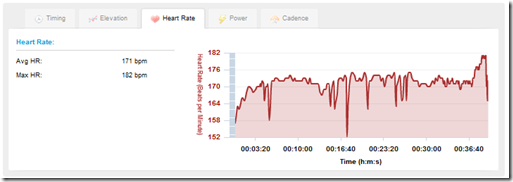 |
| From there you’ll notice along
the bottom you can change to the different views
– showing such detail as Heart Rate, Speed, and
depending on the accessories you have – Cadence,
Power Data, etc…
You can also click to display splits for each
activity:
|
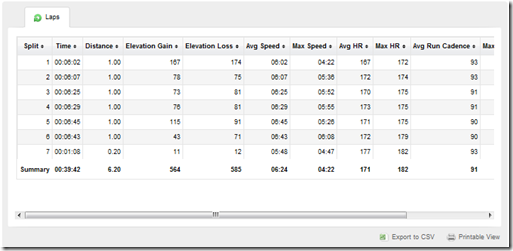 |
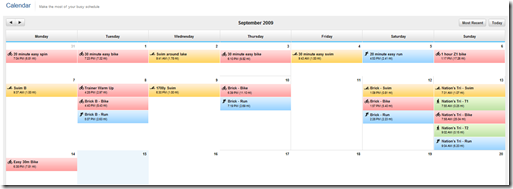 |
| While showing you tons of cool
screenshots is worthwhile, it’d probably be more
fun for you to play with it yourself. So here
ya go, three activities that I recorded this
past weekend that you can interactively poke
around at and play with all the features of
Garmin Connect:
Swim,
Bike,
Run. Next up is the ability to see it all
in a simple calendar format. This is useful if
you’re trying to understand how your training
flows from week to week:
Finally, you can generate reports, create
goals and even track items like your weight and
generate reporting based on that.
|
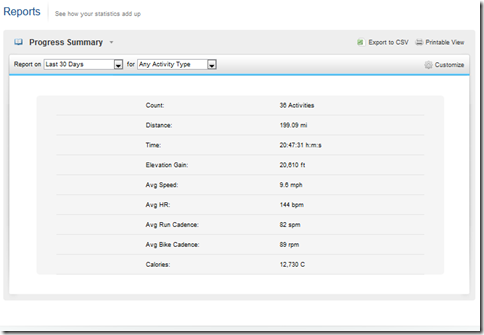 |
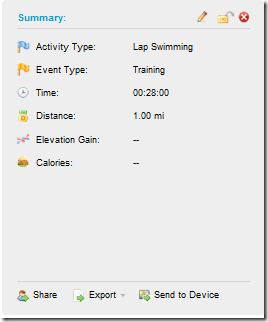 |
| One recent addition (in the last
few weeks), is the ability to manually add an
activity not recorded on the Garmin. For
example, if you go for a swim at the pool and
just do laps. You can see a list of upcoming
features to be implemented, as well as recently
implemented features here. It’s pretty
unusual for a software company to publish a list
of features/fixes they are working on – so huge
props to the GC team for doing it. Now while
Garmin Connect has made great strides as an all
purpose workout tool and putting it in the
category of ‘good’, I still think it has a ways
to go with respect to being a ‘great tool’. For
example, when you look at swim workouts, the
distance is in miles – not meters or yards.
Nobody enters in swim workouts in miles.
Also, I find that the site is fairly slow in
general. That said, as an all around workout
planner I think it hits the target for the vast
majority of the population.
Garmin Training Center
Garmin Training Center (GTC) is Garmin’s
old-school style tool for placing data on the
Garmin devices. It also allows you to download
data from it. But, the reality is this tool
isn’t being updated any more by Garmin aside
from critical changes needed to support new
devices. And the reasons are plentiful – the
tool is fairly antiquated and almost all of the
functionality is on Garmin Connect, with the
exception of loading workouts into the watch.
|
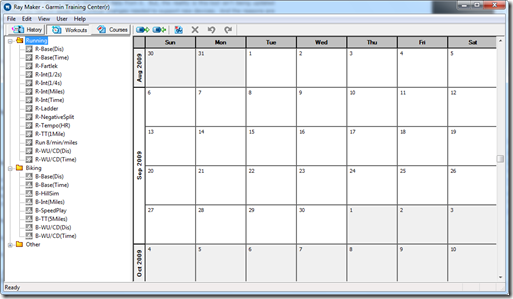 |
 |
| As you can see below, the map
functionality within the tool is extremely basic
when compared with Garmin Connect (above,
earlier): So, while you will probably
install GTC, it’s unlikely you’ll use it much.
That said, if you’re interested in learning how
to download workouts to your watch – read
through this post I wrote a bit back. It
goes through how to download workouts to all the
major watches (and the 310XT works identically
to the 305 in this respect).
Training Peaks:
One of the most common application used by
endurance athletes and coaches is
Training Peaks. Training Peaks is in many
ways similar to Garmin Connect – with the
exception that it’s designed to allow coaches
and athletes to interactively review and analyze
workouts. I use Training Peaks to upload my
workouts daily so that my coach can then review
and comment on them. They have both a free
version, and paid versions.
|
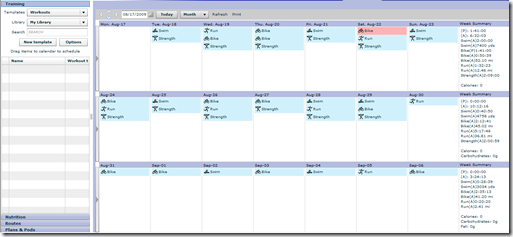 |
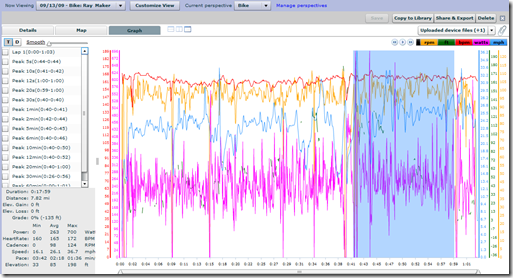 |
| Within each activity you can
drill down and review detailed information about
any section you choose:
From the above you can see the summary of the
highlighted section at the bottom of the
screen. As you can see, for detailed analysis
of data – such as power data, TP is extremely
helpful. The above is a screenshot of the same
bike race as the earlier screenshot in the Power
Meters section from Garmin Connect – you can see
the significant differences in detail offered.
Training Peaks also has a pretty useful
dashboard that you can customize to display pods
of data:
|
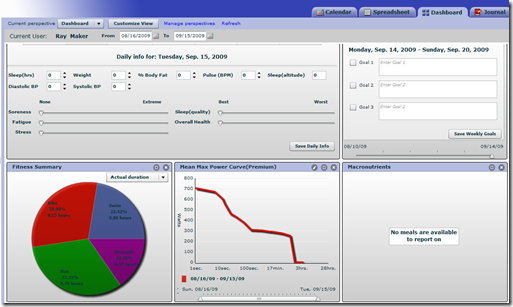 |
 |
| Training Peaks has updated their
device agent software to now support the 310XT
directly, so you can easily upload right from
your desktop to Training Peaks.
Sport Tracks:
Last but not least…Sport
Tracks. Sport Tracks is another non-Garmin
option available to users of the 310XT. It
leverages the ANT+ Agent noted above to pull
workouts into it. Sport Tracks is completely
free and put together by a huge community of
sports enthusiasts, designed to support the
maximum number of devices – including the Garmin
310XT. Below is the main page of Sport Tracks.
|
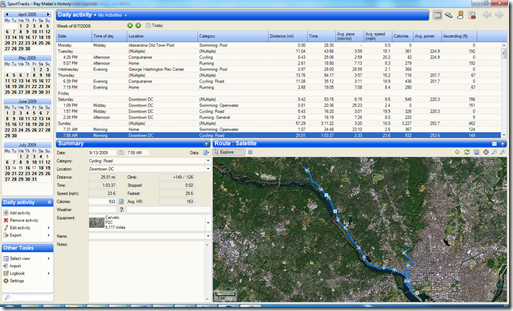 |
 |
| Once you’ve selected a given
activity, you can drill down into many of the
different details of that given workouts, such
as for example – power when cycling, like the
below: Sport Tracks also allows you to
generate customized reports 18 different ways to
Sunday:
|
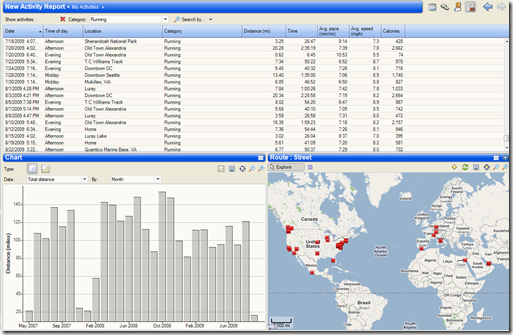 |
 |
| Perhaps one of the coolest
features of Sport Tracks is the ability to
install free plug-ins. There are close to a
hundred different plug-ins, offering all sorts
of interesting features. For example, one that
I use automatically corrects the elevation based
on NASA data, as GPS-based elevation is often
filled with errors. Check out
all the plug-ins I use for Sport Tracks
here. Go give it a shot though. If you
like the ability to endlessly analyze your data
– I’d highly recommend Sport Tracks.
Summary:
In summary, the
Forerunner 310XT is a significant jump
forward from the 305. In my opinion it offers
compelling new features, while at the same time
polishing much of the user interface of the
305. However, let’s go through a quick list of
pro’s and con’s, before getting to the all
important question of 310XT vs 305:
Pro’s/Cons:
No review would be complete without this all
important section, so let’s get on with it
bubbling down many many pages of detailed
information into about a dozen lines of text:
First up, the pro’s:
- Ability to last 20 hours
- Ability to stay underwater for extended
periods of time
- Ability to connect to ANT+ Power Meters
- Smaller form factor (size)
- Wirelessly sync’s to computer (though, some
also see this as a con)
- Cleaned up user interface
- Much faster satellite reception
And then the con’s:
- Waterproofing is more form than function
- HR, pace and distance don’t really work in the
water
- More than double the price of the Garmin
Forerunner 305
- Common power features missing
- No more fabric strap (though I see this likely
changing)
But now the question everyone’s been waiting for
– do you choice the 310XT or 305? The answer
is…it depends.
See, it depends on how you’re going to use
it. If you’re going to be solely using it for
running and going less than 10 hours at a time,
then there honestly isn’t a reason aside from
cosmetics to purchase the 310XT over the 305 (or
for that matter, instead of the 405/405CX –
which are geared for runners). That said, check
out my almost as long
Garmin 305 review (updated just earlier this
summer) to help get an idea of the features
there.
But if you’re a cyclist, triathlete or
multisport person, then you need to dig deeper
into the ‘depends’ question. In particular –
the following three items:
1) If you’re a cyclist/triathlete who uses
power meters, then the 310XT, 500 and 705 are
your only choices, as those are the only current
Garmin devices that can do ANT+ power meters.
2) If you’re a swimmer then I highly
recommend looking at the 310XT merely from the
convenience of not having to worry about the
waterproofing. While I’m a huge fan of the
305 in your swim cap, it is susceptible to
water damage for prolonged periods. The 310XT
removes that worry from my life.
3) If you’re a runner who needs 10-20 hours
of battery life, then the 310XT gives you that.
Same goes for competitors in an Ironman needing
more than 10 hours of battery life on one
watch. Sure you can
use accessories to extend that duration, but
honestly, that’s kinda a pain long-term.
So with that, will I buy one? The
answer is simple: Yes.
Even with having the Edge 500/705 for cycling
with power, I like having the ability to switch
to the 310XT when it seems appropriate.
Further, I’ve found it’s so much easier to take
it along on swims now that I don’t have to worry
and fret about whether or not it will survive
that aquatic adventure. Finally I’ve found the
device just far more polished than the 305 –
even despite many of the fumbles with initial
firmware revisions on the 310XT.
Hopefully you found this review useful. At
the end of the day, I’m an athlete just like you
looking for the most detail possible on a new
purchase – so my review is written from the
standpoint of how I used the device.
|
 View
Full Album View
Full Album |
| I took a lot of pictures over
the course of writing this review – 292 of them
to be exact. And I know that a lot of folks
(like myself) like to see different angles of
the product used in different ways. So instead
of just leaving them on my hard drive forever,
I’ve taken a fair chunk of them and put them up
in this little gallery above for you to be able
to browse through. Found this review
useful? Here’s the super easy no-pain way you
can help support future reviews! Read on…
The reviews generally take 20-40 hours to put
together, so it’s a fair bit of work (and labor
of love). Also, as you probably noticed by
looking below, I take time to answer all the
questions posted in the comments – and there’s a
lot of details in there as well. So if you
found this review helpful in your purchasing
decision, you can support future reviews
like this by using any of the Amazon links
(accessories or the units themselves). As
noted earlier, there are two versions available
of the Garmin 310XT – one without the HR strap,
and one with the Premium HR strap. They go for
basically
$350ish respectively (obviously if you plan
to buy the HR strap, you’ll save money and buy
the bundle).
Here’s the quick table of all the accessories
offered (or that work with) the Garmin 310XT:
|
|






